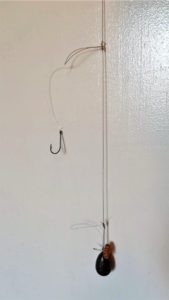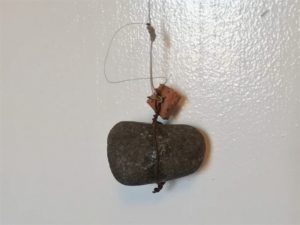
10 rough ground fishing tips to limit tackle loss
Every angler knows the feeling. The conditions are perfect. Your freshly baited rig is in exactly the right spot. You know you are fishing rough ground, but everything screams fish… You feel a knock, then another one… The next moment your rod is almost pulled out of your hands. When you strike it feels heavy, solid. Maybe a bit too solid as nothing seems to move, not even a bit: you’re snagged.
Losing tackle in snags isn’t just costing you a lot of money, it also consumes a lot of your precious fishing time. Trying to pull for a break, tying up again and again…
So how can we spend less time cursing and more time catching? Here’s how:
1. Use a float
Float fishing is an underrated method when it comes to sea fishing. There’s hardly a species that can’t be caught this way. You can fish at any depth with a float, from near the surface to right at the bottom. It is also a great way to measure the differences in depths and find the real fish holding hotspots. Because the line is in the water vertically, the chances of getting snagged are a lot lower. If you do get snagged, however, and you use ahook length with a lower breaking strain than your mainline, nine times out of ten all you lose is your hook – just tie a new one on and you’re good to go again. For more information, see my article on saltwater float fishing.
2. Go weedless
When lure fishing rough ground, especially in kelpy areas, there is no better way to limit tackle loss than by using weedless hooks. Weedless hooks are off-set hooks, that allow you to bury the hook in the soft lure, while the lure remains straight and retains its normal action. When a fish attacks the lure, the hook will pop out and you hook the fish just like with any normal lure. Some lures have a small sloth, which makes fishing it weedless even easier. You can either fish these rigs on a trace (Carolina style) or with a bullet weight next to the hook (Texas style). I was sceptical about these hooks at first, but they do work a treat.
3. Avoid treble hooks
Treble hooks are very effective when hooking fish, but they’re very good in hooking everything else too. If you want to make sure you lose your lure on the first cast, use a treble hook. I would avoid using spinners and other silver or hard baits when fishing rough ground, but if you really have to, replace the trebles by single hooks. Depending on what kind of lure you’re using, you might want to use inline single hooks. If you’re practising catch and release, these hooks are a lot kinder to the fish too. There are also weedless treble hooks on the market, but I would still go for single hooks to reduce the chances of getting snagged.
4. Keep it off the bottom
This sounds obvious, but if you are targeting fish in mid-water like mackerel and sometimes pollock, don’t wait until your lure reaches the bottom but start reeling in once you are at the desired depth. To bring in the rig when you’re bottom fishing, give it a good tug, then reel in as fast as you can to avoid getting snagged.
5. Keep it simple

If you are bait fishing over rough ground, keep your rigs as simple as possible. The more components you use, the more there is to snag. My favourite rough ground rig consists of a hook, a weight and a rotten bottom pin (see picture). As a general rule, your mainline should have the highest breaking strength (e.g 30lbs), then your hook length (e.g. 20 lbs), and then the line (weak link) to your weight (e.g 10 lbs*). This way, if one part of your rig gets snagged, you only lose that part. And more importantly, if your weight gets snagged while you’re on to a fish, you still get to land the fish. For more info on rough ground cod rigs, see this post.
* In most cases you will need to use a rotten bottom clip to prevent the line from breaking during the cast. If you are fishing at close range with lighter weights, you can leave the clip out, but might want use a stronger weak link (e.g. 15 lbs). If you are pendulum casting you will have to use a shock leader (10 lbs for every ounce).
When to use a pulley rig
A pulley rig is very effective if you are fishing past rocks and other snags. It lifts the lead above the fish, which makes it a lot easier to bring it in over these obstacles. I wouldn’t drop a pulley rig straight into the kelp though. There is simply too much to tangle and wrap itself around the kelp. The same holds for lead lifts: good for fishing past rocks, but straight into the rough it’s just another thing to get snagged.
6. Never use rigs with more than one hook on them when fishing over rough ground
Using several hooks when rough ground fishing is asking for trouble. The only faster way to lose your tackle is to empty the contents of your tackle box into the water. Even if you manage to hook a fish on one of the hooks, one of the other ones is still likely to get snagged – making you lose the rig and the fish. Feather rigs are the worst, but I wouldn’t use a pennel rig either. Apart from the costs and the environmental consequences you’re also creating a lot more snags for yourself and others by leaving all those lines and hooks underwater.
7. Use short hooklengths
Long snoods are more likely to wrap around kelp and other obstacles. Six or seven inches is often more than enough.
8. Use alternative weights

At a lot of the marks I fish, the fish are often very close in. In these situations, especially when the ground is very rough, I happily use a stone (see picture) instead of a lead weight. I often lose about twenty stone weights during a session, just imagine the costs (and pollution) if I would use lead weights instead. Other people use spark plugs or old worn locknuts, but I prefer stones.
9. Don’t use big hooks
Unless you’re after conger, there is no need for massive hooks. Big hooks snag easier and are harder to bend out. In most situations I find a wide gape 2/0 is ideal – it’s big enough for crab baits or bigger fish sections, but it will still bend out under pressure.
10. Take your time to get to know new rough ground fishing marks
Before casting your rig into the big unknown, take your time to explore new marks. Go there at low tide and see which obvious snags are exposed. Take pictures and mark the spots where you want to cast. For deep water marks it’s always worth casting a few times with nothing but a lead weight on the end of your line. This will give you an idea of the differences in depth and where the bigger snags are.

I hope this article was helpful to you. If you have any other tips on how to lose less tackle when fishing rough ground, don’t hesitate to leave them in the comment section below.
And if you’d like to receive an email every time I publish a new post, please subscribe to my newsletter. Tight lines!
Disclosure: if you purchase anything using the links in this blog post, I might make a commission. Affiliate programs and affiliations include, but are not limited to, the eBay Partner Network. It doesn’t cost you a penny more to buy via these affiliate links (and you don’t have to use them of course) but it helps me to keep this blog going. Thanks!

6 thoughts on “10 rough ground fishing tips to limit tackle loss”
Helpful tips!
Wondering if that’s a cod in the last shot.
Thanks! It’s a pollock.
Good article, great info, thanks.
Thanks, good to hear!
Thanks for the information and experience u shared, I am from, Anjuna, Goa India.
We have a rough ground beach shelf and shore . I do a lot of fishing during the sea is rough and stormy ,it’s fun Would need some information about the rod length for a multiplier reel to use in rough ground and would be changing my location accordingly.
Hi George, that sounds like interesting fishing ground. Personally I prefer a rod between 12ft and 13ft for my beach fishing, whether clean ground or rough. A longer rod will help you to reach bigger distances, but it can also ‘get in the way’, especially when space is limited (like on most rock marks). For rough ground fishing I prefer a sturdy rod with a lot of backbone, which makes it easier to keep the fish out of the snags. I use a fixed spool reel with a fast retrieve for rough ground fishing because it helps me to get my rig off the bottom (and away from snags) quicker, but I know a lot of people prefer multipliers. What kind of reel you use doesn’t matter much rod length wise, but you need to make sure your rod is designed for use with a multiplier. Usually these rods are marked ‘MX’. Multiplier rods generally have more and smaller rod guides than fixed spool (FS) rods. I hope this answers your question. Tight lines!